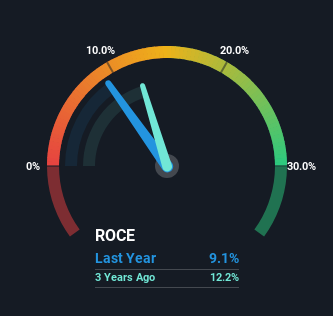Returns On Capital At Anhui Guangxin Agrochemical (SHSE:603599) Have Stalled

If you're not sure where to start when looking for the next multi-bagger, there are a few key trends you should keep an eye out for. One common approach is to try and find a company with returns on capital employed (ROCE) that are increasing, in conjunction with a growing amount of capital employed. Ultimately, this demonstrates that it's a business that is reinvesting profits at increasing rates of return. In light of that, when we looked at Anhui Guangxin Agrochemical (SHSE:603599) and its ROCE trend, we weren't exactly thrilled.
Return On Capital Employed (ROCE): What Is It?
For those that aren't sure what ROCE is, it measures the amount of pre-tax profits a company can generate from the capital employed in its business. To calculate this metric for Anhui Guangxin Agrochemical, this is the formula:
Return on Capital Employed = Earnings Before Interest and Tax (EBIT) ÷ (Total Assets - Current Liabilities)
0.091 = CN¥892m ÷ (CN¥15b - CN¥5.0b) (Based on the trailing twelve months to March 2024).
So, Anhui Guangxin Agrochemical has an ROCE of 9.1%. On its own that's a low return, but compared to the average of 5.6% generated by the Chemicals industry, it's much better.
Check out our latest analysis for Anhui Guangxin Agrochemical

In the above chart we have measured Anhui Guangxin Agrochemical's prior ROCE against its prior performance, but the future is arguably more important. If you're interested, you can view the analysts predictions in our free analyst report for Anhui Guangxin Agrochemical .
So How Is Anhui Guangxin Agrochemical's ROCE Trending?
There are better returns on capital out there than what we're seeing at Anhui Guangxin Agrochemical. The company has employed 103% more capital in the last five years, and the returns on that capital have remained stable at 9.1%. This poor ROCE doesn't inspire confidence right now, and with the increase in capital employed, it's evident that the business isn't deploying the funds into high return investments.
Another point to note, we noticed the company has increased current liabilities over the last five years. This is intriguing because if current liabilities hadn't increased to 34% of total assets, this reported ROCE would probably be less than9.1% because total capital employed would be higher.The 9.1% ROCE could be even lower if current liabilities weren't 34% of total assets, because the the formula would show a larger base of total capital employed. So while current liabilities isn't high right now, keep an eye out in case it increases further, because this can introduce some elements of risk.
In Conclusion...
In summary, Anhui Guangxin Agrochemical has simply been reinvesting capital and generating the same low rate of return as before. Although the market must be expecting these trends to improve because the stock has gained 59% over the last five years. However, unless these underlying trends turn more positive, we wouldn't get our hopes up too high.
Anhui Guangxin Agrochemical does come with some risks though, we found 2 warning signs in our investment analysis, and 1 of those is concerning...
For those who like to invest in solid companies, check out this free list of companies with solid balance sheets and high returns on equity.
New: Manage All Your Stock Portfolios in One Place
We've created the ultimate portfolio companion for stock investors, and it's free.
• Connect an unlimited number of Portfolios and see your total in one currency
• Be alerted to new Warning Signs or Risks via email or mobile
• Track the Fair Value of your stocks
Have feedback on this article? Concerned about the content? Get in touch with us directly. Alternatively, email editorial-team (at) simplywallst.com.
This article by Simply Wall St is general in nature. We provide commentary based on historical data and analyst forecasts only using an unbiased methodology and our articles are not intended to be financial advice. It does not constitute a recommendation to buy or sell any stock, and does not take account of your objectives, or your financial situation. We aim to bring you long-term focused analysis driven by fundamental data. Note that our analysis may not factor in the latest price-sensitive company announcements or qualitative material. Simply Wall St has no position in any stocks mentioned.
About SHSE:603599
Anhui Guangxin Agrochemical
Researches, develops, produces, and sells pesticides and phosgene products in China.
Adequate balance sheet and fair value.
Market Insights
Community Narratives



